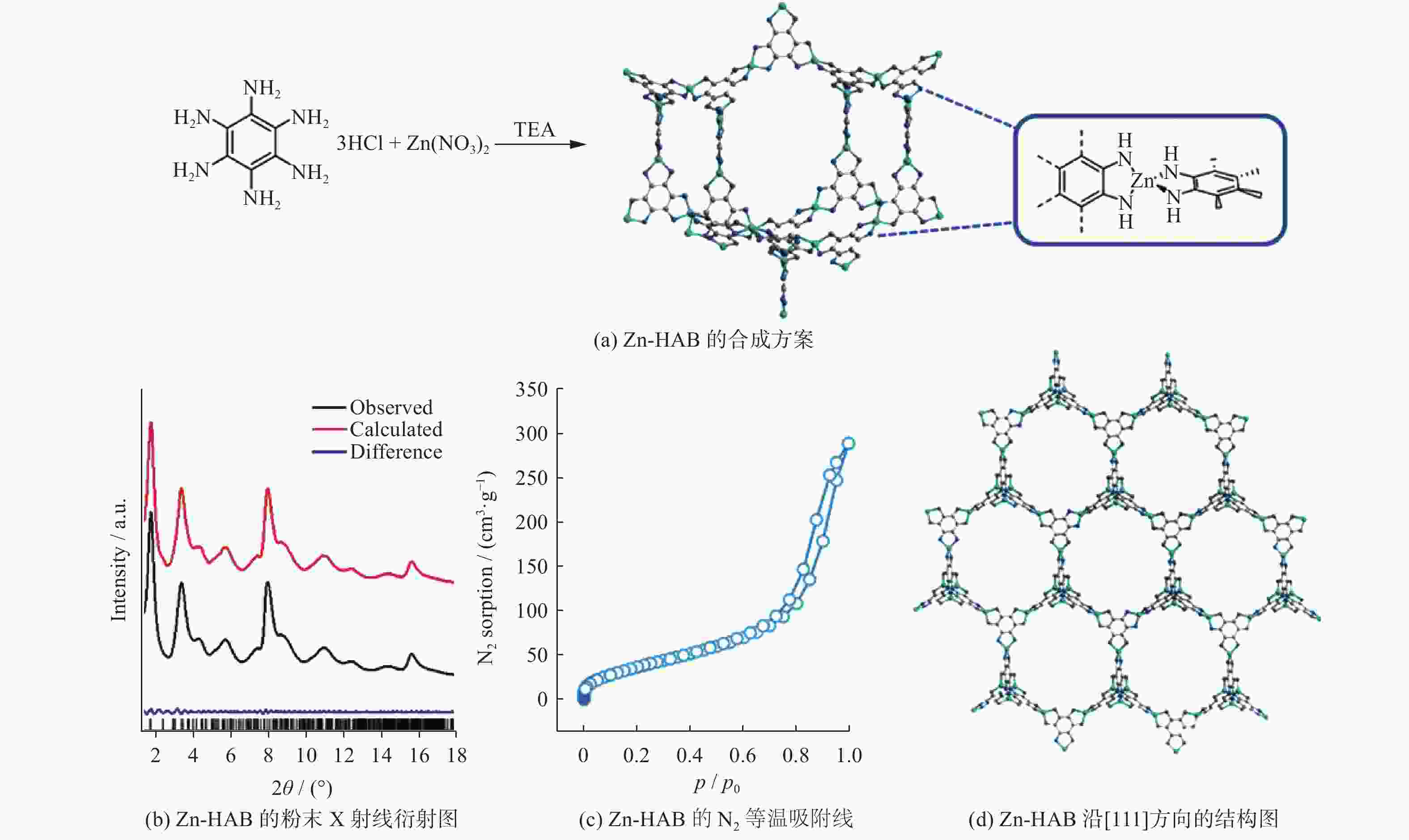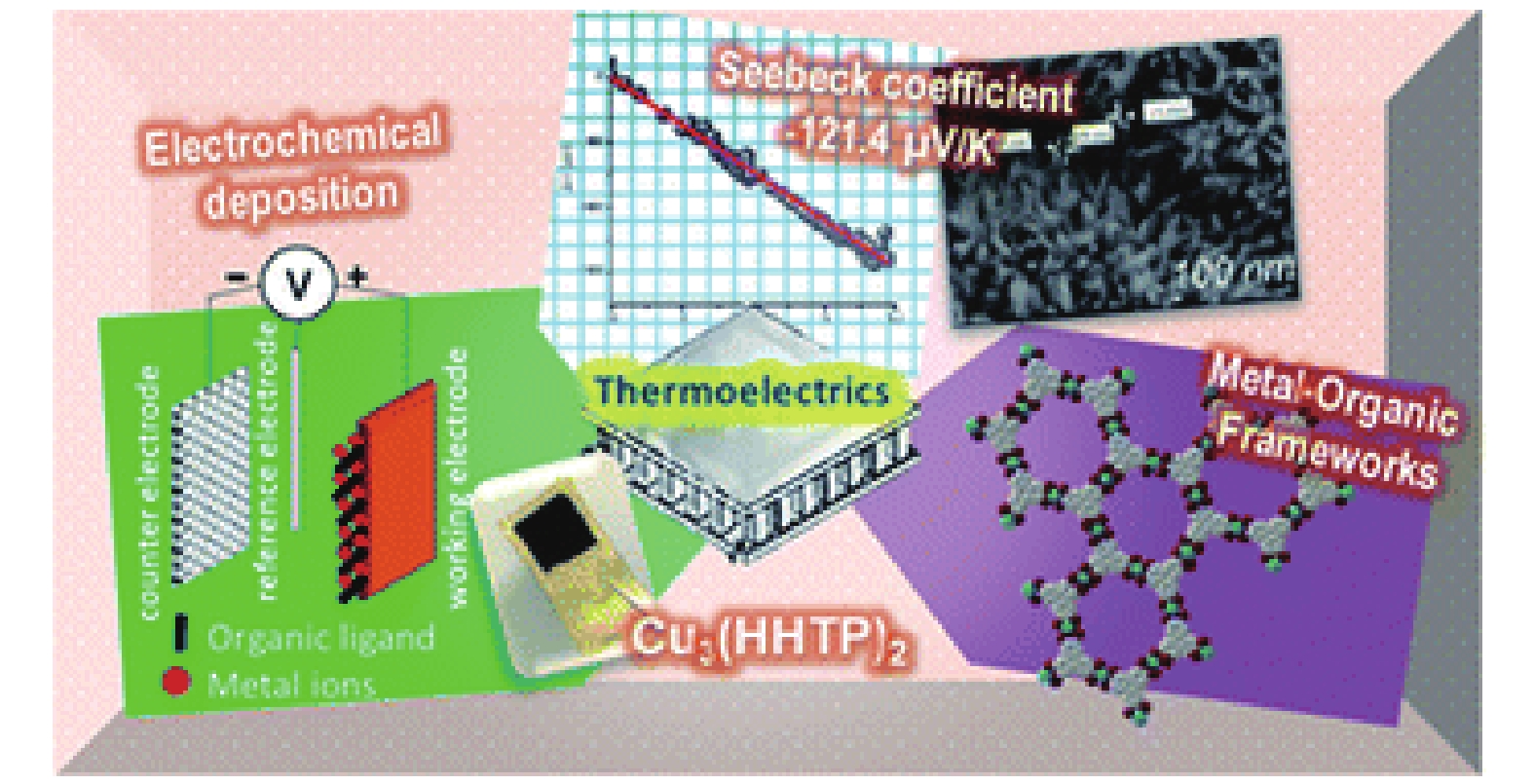Research Progress of Conductive Metal-Organic Frameworks in Thermoelectric Materials
-
摘要: 金属有机框架(MOFs)是一种高度有序的晶体多孔固体材料,通过一系列实验设计策略,可构建高电导率的MOFs,其是极具潜力的热电材料. 从导电MOFs的结构、导电机制及其热电应用几个方面阐述导电MOFs在热电材料领域的研究进展,同时总结其在热电材料领域面临的挑战和发展方向,为新型MOFs基热电材料的开发提供参考.Abstract: Metal-organic frameworks (MOFs) are highly-ordered and crystalline porous materials. Through a series of experimental design strategies, MOFs with high conductivity can be constructed , which is a great potential thermoelectric materials. The research progress of conducting MOFs in the field of thermoelectric materials were reviewed from the structure, conduction mechanism and thermoelectric applications of conducting MOFs. Meanwhile, the challenges and development direction of conducting MOFs in the field of thermoelectric materials were summarized, which can provide a reference for the development of new MOFs-based thermoelectric materials.
-
表 1 导电MOFs基热电材料及性能汇总
Table 1. A summary of properties of conductive MOF based thermoelectric materials
导电MOFs 样品类型 导电机制 热导率 / (W ·(m·K)−1) 电导率 / (S ·cm−1) 塞贝克系数 / (μV ·K−1) 功率因子 / (μW·m−1·K−1) Ni3(HITP)2[25] 压片 扩展共轭 0.21 58.8 −11.9 0.831 Cu3(HHTP)2[9] 压片 扩展共轭 — 3.80×10−3 −7.24 2×10−5 Cu3(HHTP)2[9] 薄膜 扩展共轭 — 2.28×10−3 −121.4 3.15×10−3 Cu3(BHT)[26] 薄膜 扩展共轭 0.24 2 000 −21 88.2 Ni-PTC[18] 压片 扩展共轭 0.20 9.0 47 2.0 Zn-HAB[11] 压片 扩展共轭 — 8.6×10−4 200 3.44×10−3 TCNQ@Cu3(BTC)2[10] 薄膜 客体促进 0.27 4×10−3 375 0.057 Zr-MOF/PAn/PSS[27] 薄膜 客体促进 0.24 0.021 −17780 664 ZIF-67@CNT[28] 薄膜 客体促进 4.10±0.60 825.7±12.0 55.6±0.9 255.6±11.8 -
[1] TRITT T M, SUBRAMANIAN M A. Thermoelectric materials, phenomena, and applications: A bird’s eye view[J] . MRS Bulletin,2006,31(3):188 − 198. doi: 10.1557/mrs2006.44 [2] POUDEL B, HAO Q, MA Y, et al. High-thermoelectric performance of nanostructured bismuth antimony telluride bulk alloys[J] . Science,2008,320(5876):634 − 638. doi: 10.1126/science.1156446 [3] SNYDER G J, TOBERER E S. Complex thermoelectric materials[J] . Nature Materials,2008,7(2):105 − 114. doi: 10.1038/nmat2090 [4] SINGH S, LEE S, KANG H, et al. Thermoelectric power waves from stored chemical energy[J] . Energy Storage Materials,2016,3:55 − 65. doi: 10.1016/j.ensm.2016.01.004 [5] ROWSELL J L C, YAGHI O M. Metal-organic frameworks: A new class of porous materials[J] . Microporous and Mesoporous Material,2004,73(1/2):3 − 14. doi: 10.1016/j.micromeso.2004.03.034 [6] MURRAY LJ, DINCĂ M, LONG J R. Hydrogen storage in metal- organic frameworks[J] . Chemical Society Review,2009,38(5):1294 − 1314. doi: 10.1039/b802256a [7] LI P L, SHEN Y L, WANG D D, et al. Selective adsorption-based separation of flue gas and natural gas in zirconium metal-organic frameworks nanocrystals[J] . Molecules,2019,24(9):1822. doi: 10.3390/molecules24091822 [8] LEE J, FARHA O K, ROBERTS J, et al. Metal-organic framework materials as catalysts[J] . Chemical Society Reviews,2009,38(5):1450 − 1459. doi: 10.1039/b807080f [9] De LOURDES GONZALEZ-JUAREZ M, FLORES E, MARTIN-GONZALEZ M, et al. Electrochemical deposition and thermoelectric characterisation of a semiconducting 2-D metal–organic framework thin film[J] . Journal of Materials Chemistry A,2020,8(26):13197 − 13206. doi: 10.1039/D0TA04939E [10] ERICKSON K J, LEONARD F, STAVILA V, et al. Thin film thermoelectric metal-organic framework with high seebeck coefficient and low thermal conductivity[J] . Advanced Materials,2015,27(22):3453 − 3459. doi: 10.1002/adma.201501078 [11] PARK J, HINCKLEY A C, HUANG Z H, et al. High thermopower in a zn-based 3d semiconductive metal–organic framework[J] . Journal of the American Chemical Society,2020,142(49):20531 − 20535. doi: 10.1021/jacs.0c09573 [12] LEE H, VASHAEE D, WANG D Z, et al. Effects of nanoscale porosity on thermoelectric properties of SiGe[J] . Journal of Applied Physics,2010,107(9):094308 − 094314. doi: 10.1063/1.3388076 [13] SUN L, CAMPBELL M G, DINCĂ M. Electrically conductive porous metal–organic frameworks[J] . Angewandte Chemie International Edition,2016,55(11):3566 − 3579. doi: 10.1002/anie.201506219 [14] MINNICH A J, DRESSELHAUS M S, REN Z F, et al. Bulk nanostructured thermoelectric materials: current research and future prospects[J] . Energy & Environmental Science,2009,2(5):466 − 479. [15] TAKAISHI S, HOSODA M, KAJIWARA T, et al. Electroconductive porous coordination polymer cu[cu(pdt)2] composed of donor and acceptor building units[J] . Inorganic Chemistry,2009,48(19):9048 − 9050. doi: 10.1021/ic802117q [16] XIE LS, SKORUPSKII G, DINCĂ M. Electrically conductive metal-organic frameworks[J] . Chemical Reviews,2020,120(16):8536 − 8580. doi: 10.1021/acs.chemrev.9b00766 [17] LI W H, DENG W H, WANG G E, et al. Conductive MOFs[J] . EnergyChem,2020,2(2):100029. doi: 10.1016/j.enchem.2020.100029 [18] CHEN Z J, CUI Y T, JIN Y G, et al. Nanorods of a novel highly conductive 2D metal–organic framework based on perthiolated coronene for thermoelectric conversion[J] . Journal of Materials Chemistry C,2020,8(24):8199 − 8205. doi: 10.1039/D0TC01778G [19] TALIN A A, CENTRONE A, FORD A C, et al. Tunable electrical conductivity in metal-organic framework thin-film devices[J] . Science,2014,343(6166):66 − 69. doi: 10.1126/science.1246738 [20] SUN L, MIYAKAI T, SEKI S, et al. Mn2(2,5-disulfhydrylbenzene-1,4-dicarboxylate): A microporous metal-organic framework with infinite (−Mn–S−)∞ chains and high intrinsic charge mobility[J] . Journal of the American Chemical Society,2013,135(22):8185 − 8188. doi: 10.1021/ja4037516 [21] SUN L, HENDON C H, MINIER M A, et al. Million-fold electrical conductivity enhancement in Fe2(DEBDC) versus Mn2(DEBDC) (E=S, O)[J] . Journal of the American Chemical Society,2015,137(19):6164 − 6167. doi: 10.1021/jacs.5b02897 [22] XIE L S, ALEXANDROV E V, SKORUPSKII G, et al. Diverse π-π stacking motifs modulate electrical conductivity in tetrathiafulvalene-based metal-organic frameworks[J] . Chemical Science,2019,10(37):8558 − 8565. doi: 10.1039/C9SC03348C [23] KUANG X F, CHEN S C, MENG L Y, et al. Supramolecular aggregation of a redox-active copper-naphthalenediimide network with intrinsic electron conduction[J] . Chemical Communications,2019,55(11):1643 − 1646. doi: 10.1039/C8CC10269D [24] BRYCE M R. Recent progress on conducting organic charge-transfer salts[J] . Chemical Society Reviews,1991,20(3):355 − 390. doi: 10.1039/cs9912000355 [25] SHEBERLA D, SUN L, BLOOD-FORSYTHE M A, et al. High electrical conductivity in Ni3(2,3,6,7,10,11-hexaiminotriphenylene)2, a semiconducting metal-organic graphene analogue[J] . Journal of the American Chemical Society,2014,136(25):8859 − 8862. doi: 10.1021/ja502765n [26] TSUCHIKAWA R, LOTFIZADEH N, LAHIRI N, et al. Unique thermoelectric properties induced by intrinsic nanostructuring in a polycrystalline thin-film two-dimensional metal-organic framework, copper benzenehexathiol[J] . Physica Status Solidi A,2020,217(23):2070064. doi: 10.1002/pssa.202070064 [27] LIN C C, HUANG Y C, USMAN M, et al. Zr-MOF/polyaniline composite films with exceptional Seebeck coefficient for thermoelectric material applications[J] . ACS Applied Materials & Interfaces,2019,11(3):3400 − 3406. [28] XUE Y F, ZHANG Z B, ZHANG Y C, et al. Boosting thermoelectric performance by in situ growth of metal organic framework on carbon nanotube and subsequent annealing[J] . Carbon,2020,157:324 − 329. doi: 10.1016/j.carbon.2019.10.049 [29] HEREBIAN D, BOTHE E, NEESE F, et al. Molecular and electronic structures of bis-(o-diiminobenzosemiquinonato)metal(II) complexes (Ni, Pd, Pt), their monocations and −anions, and of dimeric dications containing weak metal−metal bonds[J] . Journal of the American Chemical Society,2003,125(30):9116 − 9128. doi: 10.1021/ja030123u [30] SUN L, LIAO B, SHEBERLA D, et al. A microporous and naturally nanostructured thermoelectric metal-organic framework with ultralow thermal conductivity[J] . Joule,2017,1(1):168 − 177. doi: 10.1016/j.joule.2017.07.018 [31] HMADEH M, LU Z, LIU Z, et al. New porous crystals of extended metal-catecholates[J] . Chemistry of Materials,2012,24(18):3511 − 3513. doi: 10.1021/cm301194a [32] CAMPBELL M G, LIU S F, SWAGER T M, et al. Chemiresistive sensor arrays from conductive 2D metal–organic frameworks[J] . Journal of the American Chemical Society,2015,137(43):13780 − 13783. doi: 10.1021/jacs.5b09600 [33] MÄHRINGER A, JAKOWETZ A C, ROTTER J M, et al. Oriented thin films of electroactive triphenylene catecholate-based two-dimensional metal–organic frameworks[J] . ACS Nano,2019,13(6):6711 − 6719. doi: 10.1021/acsnano.9b01137 [34] YAO M S, LV X J, FU Z H, et al. Layer-by-layer assembled conductive metal–organic framework nanofilms for room-temperature chemiresistive sensing[J] . Angewandte Chemie International Edition,2017,56(52):16510 − 16514. doi: 10.1002/anie.201709558 [35] SMITH M K, JENSEN K E, PIVAK P A, et al. Direct self-assembly of conductive nanorods of metal–organic frameworks into chemiresistive devices on shrinkable polymer films[J] . Chemistry of Materials,2016,28(15):5264 − 5268. doi: 10.1021/acs.chemmater.6b02528 [36] LI W H, DING K, TIAN H R, et al. Conductive metal-organic framework nanowire array electrodes for high-performance solid-state supercapacitors[J] . Advanced Functional Materials,2017,27(27):1702067. doi: 10.1002/adfm.201702067 [37] KAMBE T, SAKAMOTO R, HOSHIKO K, et al. π-conjugated nickel bis(dithiolene) complex nanosheet[J] . Journal of the American Chemical Society,2013,135(7):2462 − 2465. doi: 10.1021/ja312380b [38] KATO R. Conducting metal dithiolene complexes: Structural and electronic properties[J] . Chemical Reviews,2004,104(11):5319 − 5346. doi: 10.1021/cr030655t [39] HUANG X, SHENG P, TU Z, et al. A two-dimensional π–d conjugated coordination polymer with extremely high electrical conductivity and ambipolar transport behaviour[J] . Nature Communications,2015,6:7408. doi: 10.1038/ncomms8408 -






 下载:
下载:






